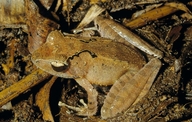|
Description
M 38-43 mm. This species is morphologically extremely similar to G. luteus and appears to replace that species at mid-altitudes. The only possible difference are the indistinct and sometimes not recognizable femoral glands in males of G. sculpturatus (Glaw and Vences 2007).
Variation: Although this species appears to be quite clearly defined by its calls, the individuals studied so far are genetically very similar to G. luteus, questioning the validity of G. sculpturatus. A more comprehensive study of this species complex is needed (Glaw and Vences 2007). Distribution and Habitat
Country distribution from AmphibiaWeb's database: Madagascar
An’Ala, Andasibe, Ankeniheny, Fierenana, Ranomafana, Vevembe (Glaw and Vences 2007). Its recorded altitudinal range is 600-1200 m asl (Glaw and Vences 2008). It lives mainly in pristine forest, and is occasionally found in degraded forest patches (Glaw and Vences 2007). Life History, Abundance, Activity, and Special Behaviors
Habits: As for G. luteus. Throughout its distribution area, G. sculpturatus appears to occur in lower densities than G. luteus; while the latter species is regularly encountered at many coastal localities, it is much more difficult to find G. sculpturatus in some areas within its distribution area (Glaw and Vences 2007). Not found associated with water and may be a direct developer (Glaw and Vences 2008).
Calls: A loud series of up to 22 short notes which have a clear pulsed component and are of less melodious appearance than the calls of G. luteus (Glaw and Vences 2007).
Trends and Threats
This species is listed as least concern in view of its relatively wide distribution, tolerance of a degree of habitat modification, presumed large population, and because it is unlikely to be declining fast enough to qualify for listing in a more threatened category. It can tolerate some habitat degradation, but habitat is being lost to subsistence agriculture, logging, charcoal manufacture, invasion and spread of eucalyptus, increased grazing and expanding human settlement. Found in two protected areas, the Parc National de Ranomafana and Réserve Spéciale d’Analamazaotra (Glaw and Vences 2008). Possible reasons for amphibian decline General habitat alteration and loss
Habitat modification from deforestation, or logging related activities
Intensified agriculture or grazing
Urbanization
Subtle changes to necessary specialized habitat
Comments
Taken with permission from Glaw and Vences (2007).
References
Glaw, F. and Vences, M. (2008). Gephyromantis sculpturatus. In: IUCN 2008. 2008 IUCN Red List of Threatened Species. www.iucnredlist.org. Downloaded on 18 March 2009.
Glaw, F., and Vences, M. (2007). Field Guide to the Amphibians and Reptiles of Madagascar. Third Edition. Vences and Glaw Verlag, Köln.
Originally submitted by: Miguel Vences and Frank Glaw (first posted 2009-03-18)
Edited by: Catherine Aguilar (2009-04-07)Species Account Citation: AmphibiaWeb 2009 Gephyromantis sculpturatus <https://amphibiaweb.org/species/5933> University of California, Berkeley, CA, USA. Accessed Jun 11, 2025.
Feedback or comments about this page.
Citation: AmphibiaWeb. 2025. <https://amphibiaweb.org> University of California, Berkeley, CA, USA. Accessed 11 Jun 2025.
AmphibiaWeb's policy on data use.
|
